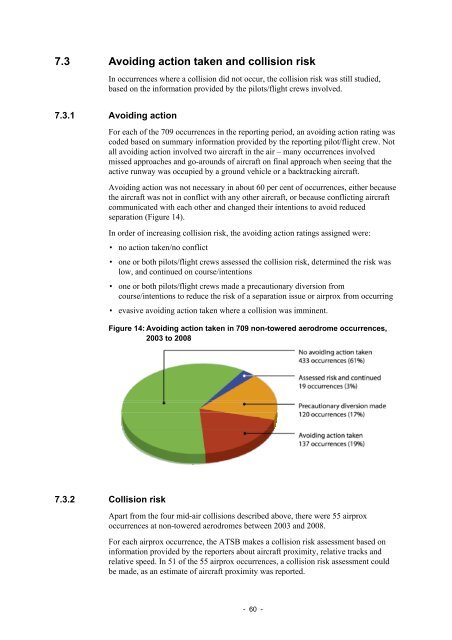Safety in the vicinity of non-towered aerodromes - Australian ...
Safety in the vicinity of non-towered aerodromes - Australian ...
Safety in the vicinity of non-towered aerodromes - Australian ...
Create successful ePaper yourself
Turn your PDF publications into a flip-book with our unique Google optimized e-Paper software.
7.3 Avoid<strong>in</strong>g action taken and collision risk<br />
In occurrences where a collision did not occur, <strong>the</strong> collision risk was still studied,<br />
based on <strong>the</strong> <strong>in</strong>formation provided by <strong>the</strong> pilots/flight crews <strong>in</strong>volved.<br />
7.3.1 Avoid<strong>in</strong>g action<br />
For each <strong>of</strong> <strong>the</strong> 709 occurrences <strong>in</strong> <strong>the</strong> report<strong>in</strong>g period, an avoid<strong>in</strong>g action rat<strong>in</strong>g was<br />
coded based on summary <strong>in</strong>formation provided by <strong>the</strong> report<strong>in</strong>g pilot/flight crew. Not<br />
all avoid<strong>in</strong>g action <strong>in</strong>volved two aircraft <strong>in</strong> <strong>the</strong> air – many occurrences <strong>in</strong>volved<br />
missed approaches and go-arounds <strong>of</strong> aircraft on f<strong>in</strong>al approach when see<strong>in</strong>g that <strong>the</strong><br />
active runway was occupied by a ground vehicle or a backtrack<strong>in</strong>g aircraft.<br />
Avoid<strong>in</strong>g action was not necessary <strong>in</strong> about 60 per cent <strong>of</strong> occurrences, ei<strong>the</strong>r because<br />
<strong>the</strong> aircraft was not <strong>in</strong> conflict with any o<strong>the</strong>r aircraft, or because conflict<strong>in</strong>g aircraft<br />
communicated with each o<strong>the</strong>r and changed <strong>the</strong>ir <strong>in</strong>tentions to avoid reduced<br />
separation (Figure 14).<br />
In order <strong>of</strong> <strong>in</strong>creas<strong>in</strong>g collision risk, <strong>the</strong> avoid<strong>in</strong>g action rat<strong>in</strong>gs assigned were:<br />
• no action taken/no conflict<br />
• one or both pilots/flight crews assessed <strong>the</strong> collision risk, determ<strong>in</strong>ed <strong>the</strong> risk was<br />
low, and cont<strong>in</strong>ued on course/<strong>in</strong>tentions<br />
• one or both pilots/flight crews made a precautionary diversion from<br />
course/<strong>in</strong>tentions to reduce <strong>the</strong> risk <strong>of</strong> a separation issue or airprox from occurr<strong>in</strong>g<br />
• evasive avoid<strong>in</strong>g action taken where a collision was imm<strong>in</strong>ent.<br />
Figure 14: Avoid<strong>in</strong>g action taken <strong>in</strong> 709 <strong>non</strong>-<strong>towered</strong> aerodrome occurrences,<br />
2003 to 2008<br />
7.3.2 Collision risk<br />
Apart from <strong>the</strong> four mid-air collisions described above, <strong>the</strong>re were 55 airprox<br />
occurrences at <strong>non</strong>-<strong>towered</strong> <strong>aerodromes</strong> between 2003 and 2008.<br />
For each airprox occurrence, <strong>the</strong> ATSB makes a collision risk assessment based on<br />
<strong>in</strong>formation provided by <strong>the</strong> reporters about aircraft proximity, relative tracks and<br />
relative speed. In 51 <strong>of</strong> <strong>the</strong> 55 airprox occurrences, a collision risk assessment could<br />
be made, as an estimate <strong>of</strong> aircraft proximity was reported.<br />
- 60 -
















